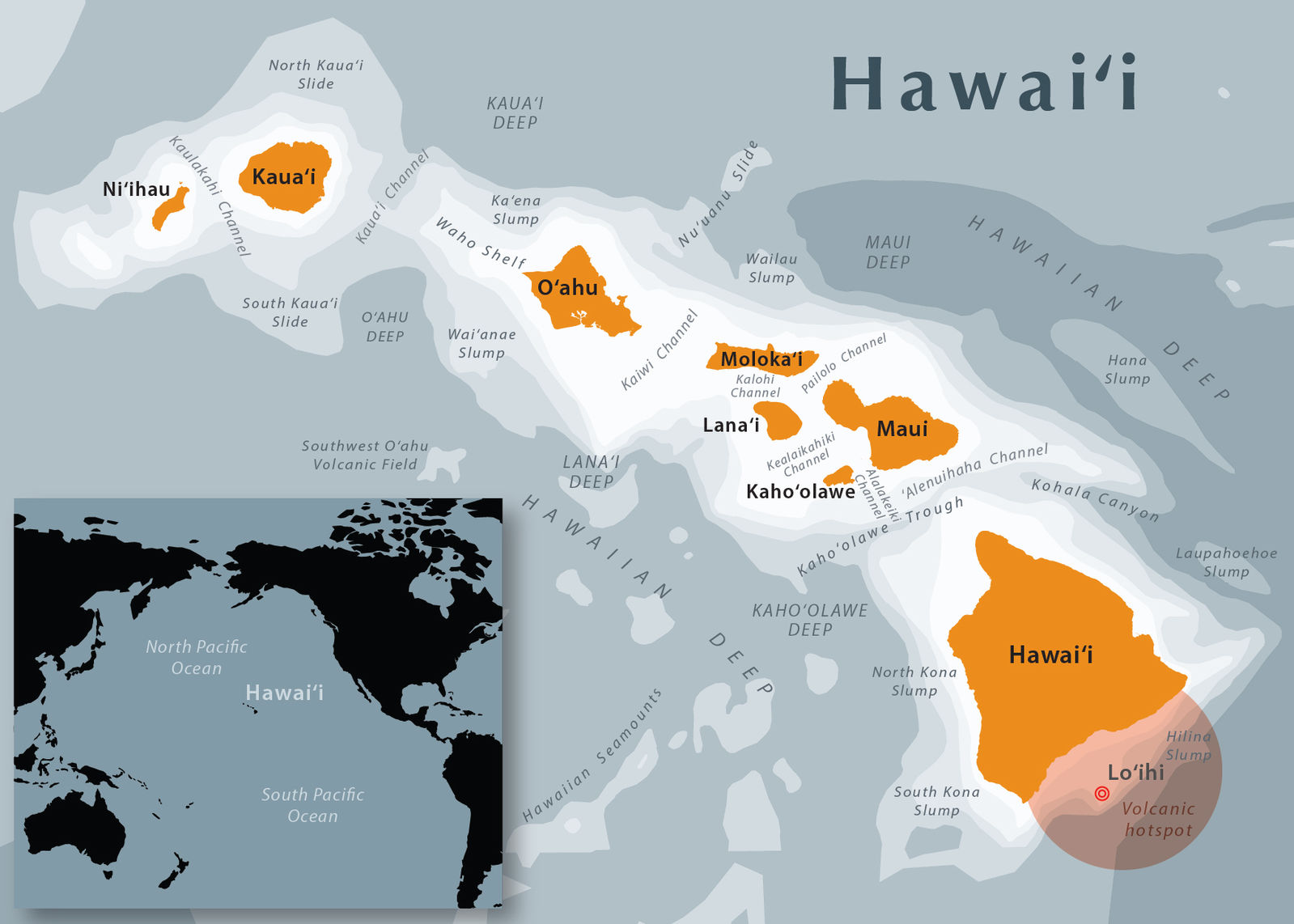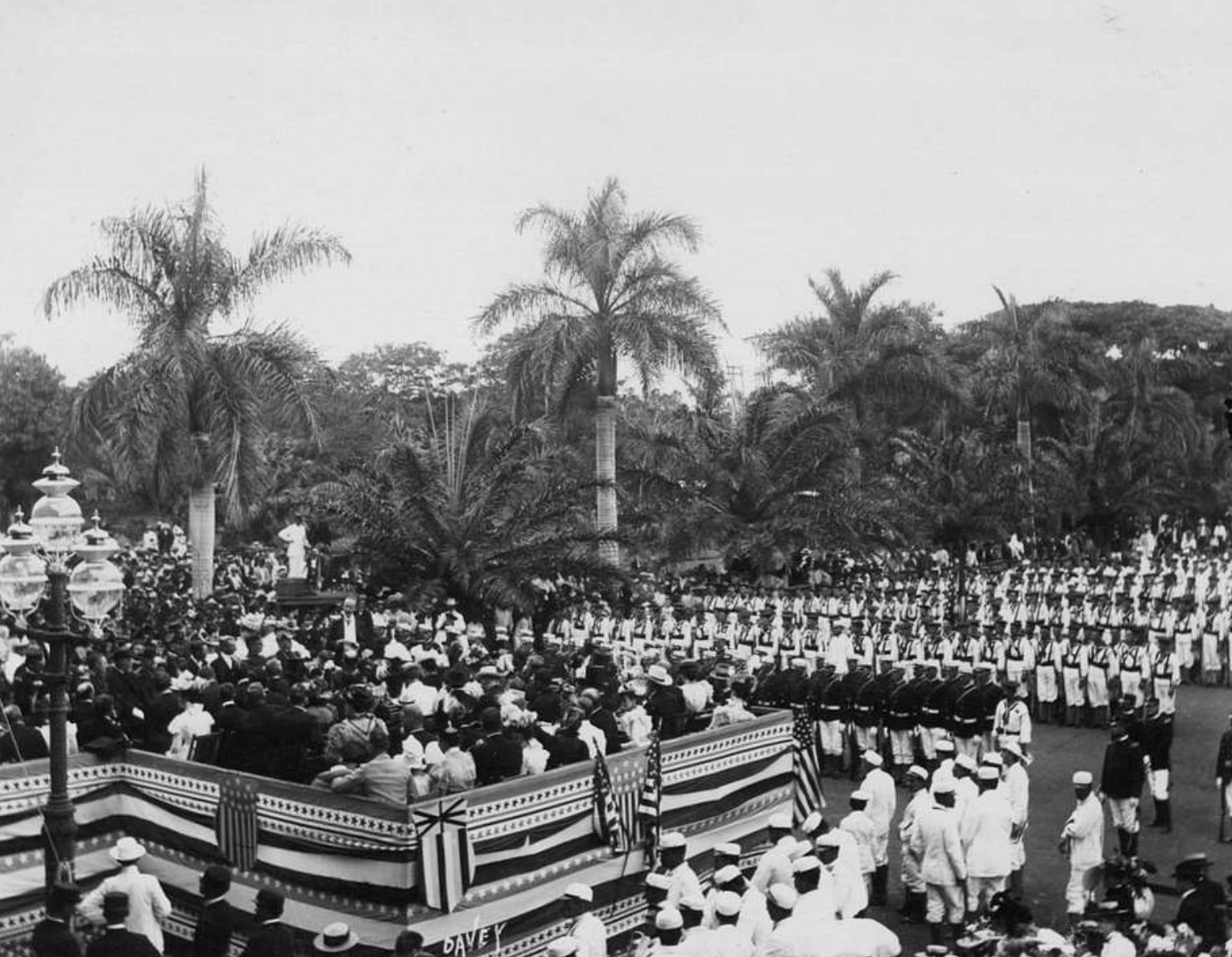1.7.2 - 'Iolani Palace: A Symbol of Hawaiian History, Identity, and Community
Instructions for teachers: This video provides an overview of Hawaiʻi’s monarchy and the achievements of its second elected king, King Kalakaua. Start the video at 4:23 (already cued in link) and stop it at 7:51. This section of the video explains King Kalakaua’s vision for ʻIolani Palace and showcases each of its rooms and their functions, giving students a glimpse of royal life in the palace.
Grade: 1Subject:
English, Social Studies, U.S. History
Number of Activities: 4 + Extension Activities
ʻIolani Palace is located in Honolulu, Hawai
ʻi. It was the official residence for the Hawaiian Kingdom’s royal family.
Credit:
Wikimedia Commons
According to the California History/Social Studies Standards, students in first grade study, “the varied backgrounds of American citizens and learn about the symbols, icons, and songs that reflect our common heritage.” However, most lessons addressing this standard tend to exclude the varied and diverse backgrounds of non-white American citizens, especially Native Hawaiians. For instance, ‘Iolani Palace represents the rich history of the Hawaiian Kingdom and it continues to serve as a symbol of Hawaiian identity; and yet, its significance is rarely taught in schools. It is important to include the perspectives and histories of Native Hawaiians and other Pacific Islanders, who struggle to preserve their identity.
This lesson addresses the following standards:
- 1.3 Students know and understand the symbols, icons, and traditions of the United States that provide continuity and a sense of community across time.
Students will:
- Describe the history of ʻIolani Palace
- Explain how ʻIolani Palace serves as a symbol of Native Hawaiian history and identity
This lesson can be completed in one instructional session or over a period of one week. Here are options for lesson implementation:
- One instructional session: Complete Activity 2 plus Discussion Questions.
- Two instructional sessions: Complete Activity 2 plus Discussion Questions and one option from Activity 4.
- Three instructional sessions: Complete Activity 2 plus Discussion Questions, one option from Activity 3, and one option from Activity 4.
- One week: Complete Activity 1, Activity 2 plus Discussion Questions, one option from Activity 3, one option from Activity 4, and one extension activity.
ʻIolani Palace - A Symbol of Hawaiian History, Identity, and Community Essay:
Today, Hawai
ʻi is a U.S. state. But, before 1959, it used to be its own kingdom. It had its own rulers. The last five rulers of Hawai
ʻi lived in
ʻIolani
Palace.
The Palace is in Honolulu. Honolulu is the capital of Hawai
ʻi. The Palace was built in 1882 on
sacred land. Some people believe it was an
ancient burial site of Hawaiian chiefs.
King Kamehameha III ruled from 1825 to 1854. He bought the lands. He turned the area into the center of royal life. The Palace was simple. But it was still the grandest house in town. Its purpose was to host important people. The rulers slept in their own homes.
Future kings added more rooms to the Palace. They added towers. They added a private library. They added bedrooms. They were inspired by European rulers. They wanted ʻIolani to look just as grand.
ʻIolani Palace was named for King Kamehameha IV. He ruled from 1855 to 1863. His given name was Alexander Liholiho Keawenui ʻIolani. The name refers to ʻIo, which means royal hawk.
Queen Lili
ʻuokalani ruled from 1891 to 1893. She was the first Hawaiian queen. She was also the last Hawaiian ruler. The U.S. government wanted Hawaiian lands for its resources. They
overthrew the Hawaiian
monarchy in 1893. They held Queen Lili
ʻuokalani under house arrest.
ʻIolani Palace became her jail.
ʻIolani Palace is special. It has many meanings. It is a
symbol of Hawaiian history and culture. It is the only official state home of royalty on U.S. soil. It also has features seen nowhere else in the world.
Activists wanted to
restore the Palace. They wanted to preserve it. Today,
ʻIolani Palace is a museum and historic landmark. It’s also a place where Native Hawaiians come together to
protest. It symbolizes Hawaiian power. It also symbolizes where Hawaiians lost their kingdom. Activists are still fighting for freedom and independence.
Bibliography:
- Ancient: of or relating to a time early in history
- Monarchy: absolute rule by a single person
- Overthrow: to cause the downfall of
- Palace: the official home of a ruler
- Preserve: to keep or save for future generations
- Protest: to fight for something
- Restore: to return to its original state
- Sacred: holy or special
- Symbol: a thing that represents or stands for something else
- What are some differences between Hawaiʻi today and Hawaiʻi in the past?
- What is ʻIolani Palace?
- Why was ʻIolani Palace built?
- Where was ʻIolani Palace built?
- What inspired the style and name of ʻIolani Palace?
- Who was Queen Liliʻuokalani? What is her connection to ʻIolani Palace?
- Why is ʻIolani Palace special?
- Why is ʻIolani Palace a historic landmark? (What does it mean to be a historic landmark?)
- Why is ʻIolani Palace a site of protest?
- How and why is ʻIolani Palace linked to the community, both in the past and the present?
Hawaiʻi is an archipelago. An archipelago is a group of islands. There are eight major islands in Hawaiʻi. Hawaiʻi is located over 2,000 miles west of California.
Activity 1:
The Importance of Symbols and Introducing ʻIolani Palace (Suggested Time: 20 minutes)
Students will be introduced to the concept of symbolism and share their prior knowledge about Hawaiʻi.
- Have students draw a picture of their “home.” Have them label all the things that make their home special to them.
- Ask students: What does home mean to you?
- Tell students that symbols are things that stand for something else. Ask them the following questions: What does your home symbolize for you? How does your home represent you?
- Tell students that symbols can be used to represent big ideas, like American identity. Have students make a list of “American” symbols (i.e., flag, eagle, cheeseburger, baseball, etc.).
- Show students a picture of the White House. Ask students the following questions:
- What is this?
- Who lives there?
- Why is it important to us?
- Show students a picture of ʻIolani Palace. Ask students if they know what this is. Have students compare and contrast ʻIolani Palace and the White House.
- Tell students that ʻIolani Palace is an important place in Hawaiʻi. If needed, show students where Hawaiʻi is on a map. Have students share their prior knowledge about Hawaiʻi (if any). Ask students what they think about when they think about Hawaiʻi.
- Tell students that they are going to learn how and why ʻIolani Palace is a symbol for Hawaiian history and culture.

Queen Liliʻuokalani ruled Hawaiʻi from 1891 to 1893. She was the first Hawaiian queen. She was the last Hawaiian ruler.
Activity 2: Exploring ʻIolani Palace’s Past and Present (Suggested Time: 40 minutes)
Students will learn about the history of ʻIolani Palace (for example, when it was built and who lived in it) and the changes the Palace has gone through over time. Students will draw connections to how ʻIolani Palace represents Hawaiʻi’s past and future.
- Read the essay aloud to students. Choose one of these options:
- OPTION 1: Create a slide deck with the essay content and add visuals. Read the essay aloud to the students.
- OPTION 2: Write each section on large chart paper. As you read each section aloud, draw visuals in collaboration with the students.
- Facilitate a discussion (see Discussion Questions) about the essay to ensure comprehension.
- Have students create a timeline based on the essay. Ask students, “How and why did ʻIolani Palace change over time?”
- Guide students on a virtual tour of ʻIolani Palace
Show students each room and have them take note of the artifacts that they notice in each room.
- Have students draw the object that stood out most to them.
- Have students pair-share with a partner and discuss why this object stood out to them and what they think the purpose is.
- Have students share out with the entire class.
- OPTIONAL: Have students watch the video (or clips of it) entitled, “A King’s Noble Vision.”
- Ask students, “What else did you learn from this video?”
- Have students add important dates to the timeline created earlier.
- Facilitate a discussion by asking the following questions:
- “How does ʻIolani Palace serve as a symbol for Native Hawaiians?”
- “How does ʻIolani Palace represent Hawaiʻi’s past?”
- “How does ʻIolani Palace represent Hawaiʻi’s present?”
- “How does ʻIolani Palace represent Hawaiʻi’s future?”
- “Why is it important to preserve ʻIolani Palace?”
- “How has your knowledge of Hawaiʻi changed after this lesson? In what ways has your perception of Hawaiʻi changed because of this lesson?”
- OPTION: Have students discuss ways that they can be a better tourist if and when they visit Hawaiʻi. Have students discuss what it means, in general, to be a responsible tourist or guest.
.jpg)
ʻIolani Palace has two floors with many rooms. Pictured here are the Grand Hall, State Dining Room, and Throne Room.
Activity 3: Inquiry Projects on ʻIolani Palace (Suggested Time per Option: 30-40 minutes)
This activity offers two options for teachers to use to have students further build their knowledge on ʻIolani Palace and to understand the power of symbols.
Teachers can choose one or more of the following options:
- OPTION 1: Have students learn more about the different rooms/areas that were restored in the palace. Have students work in small groups. Have each group learn more about one designated area or artifact of the palace. Have each group make a diorama or model replicating the room or artifact, using items available to them. Have each group write a tag or caption for their creation. Display the dioramas/models around the room and have students do a gallery work and discuss what they learned.
- OPTION 2: Have students research a palace of another ruler. Have them compare and contrast that palace to ʻIolani Palace. Have students write about why palaces are important symbols.
The U.S. government wanted Hawaiʻi for its lands and resources. They overthrew the Hawaiian monarchy in 1893. Today, activists are still fighting for freedom and independence.
Activity 4: ʻIolani Palace’s impact on Native Hawaiian Communities (Suggested Time per Option: 30 minutes)
This activity offers two options for assessing students’ comprehension about ʻIolani Palace and its importance to Native Hawaiians.
Teachers can choose one or more of the following options:
- OPTION 1: Have students choose an object that serves as a symbol of something important to them. Host a “Show and Tell” activity.
- Have each student present their objects by addressing the following questions: “What is your object? What does your object symbolize? How so?”
- Facilitate a discussion by asking students, “What would happen if someone took your object away from you? How was ʻIolani Palace taken away from Native Hawaiians? How might they have felt about it?”
- Have students write a paragraph answering this question: “Why is ʻIolani Palace important to Hawaiians?”
- OPTION 2: Show students the video of the 125th Anniversary of the Overthrow of Hawaii. Ask students to summarize what they learned.
- Facilitate a discussion by asking students, “Why did Hawaiians gather together in front of the ʻIolani Palace? How did Hawaiians in the video demonstrate their sense of community?”
- Have students create an art piece (i.e., drawing, painting, collage, etc.) that shows ʻIolani Palace as a place that provides community. Have students write a caption for their art piece that includes the following:
- Description of their art piece
- At least one way ʻIolani Palace creates community
Extension Activities (Suggested Time per Option: 30-60 minutes)
- Read aloud the “Q is for Queen Liliʻuokalani” page from A is for Asian American by Virginia Loh-Hagan. Have students summarize what they learned. Have them do more research about the Queen. (Consider showing the PBS American Masters video entitled, “Queen Liliʻuokalani - The First and Last Queen of Hawaiʻi”.)
- Have students create a classroom quilt inspired by Queen Liliʻuokalani. Make sure students include important symbols. Have them pair-share and discuss the meanings behind the designs.
- Have students act as virtual tour guides of ʻIolani Palace. Have them use the virtual tour of ʻIolani Palace and share information about the palace to family members or peers.
- Have students watch one or more of the videos about the subjects of the fourteen portraits of Hawaiian monarchs hanging in ʻIolani Palace. Have students draw a picture of the person and write a short biography.
- Have students learn more about Hawaiian Kingdom Royal Orders —insignia bestowed by Hawaiian sovereigns. Have students create their own royal order that they can use to honor themselves or someone they care about. Have students discuss the symbolism behind the royal orders and the designs.
- Have students write a letter to the Friends of Iolani Palace thanking them for their work in preserving the Palace. Have students include at least one reason why it’s important to preserve the Palace for future generations.
Note: These lessons will enhance the teacher’s knowledge. They are not designed for first graders.





.jpg)
